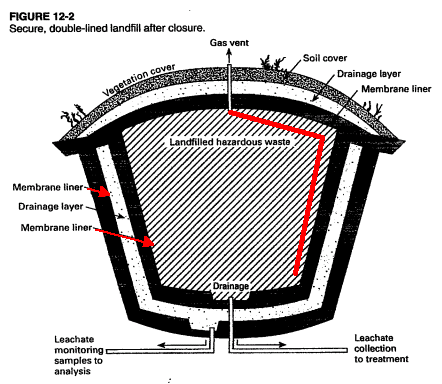 After Wentz, 1995
After Wentz, 1995
Learning Goals:
Learn the main features of a hazardous waste landfill
Understand the basics of the Land Disposal Restrictions
Hazardous Waste Landfills
Landfilling of municipal solid waste (MSW) is the most common method of disposal. Landfills of MSW are governed by Subtitle D of RCRA and numerous state and local regulations. The basics of MSW landfills have not changed in a long, long time and here I will give you a thumbnail sketch: You place the landfill as far from people's habitations as is feasible for economical transport, compact the MSW to reduce volume, cover with clean soil to keep the smell down, put up with seagulls and rats, and plant grass when the waste and soil is too high to compact. In the old days we assumed that some sort of biological treatment was going and the waste was being "treated." In 1980 I was working in Texas, building a pipeline, and we unearthed an old landfill. Our workers found readable newspapers from the early 1950's. In 30 years there had been zero biological degradation of the paper. And that was on the Texas gulf coast, a relatively warm and wet region. Some things do degrade, the stench of hydrogen sulfide indicates that, but whatever is going on, it is slow. The problem with landfills, besides fires, is that landfills leak. Liquids placed in the landfill seep downward, and rainwater leaches whatever is leachable downward. Eventually this pollutes the groundwater. Modern MSW landfills have a liner that retains fluids and the final layers of soil are of clay. Beyond that, UAF has a three-credit course in landfill design, where you could learn more.
Hazardous waste landfills are relatively new, they are governed by RCRA Subtitle C. In the old days, hazardous waste, if it was not too flammable or explosive, was dumped in with the MSW, or otherwise dumped onto the land in unpermitted landfills. As federal and state governments started to tighten up on hazardous waste practices, hazardous waste landfills became much more elaborate and expensive. Also, the public caught on and there have not been any new hazardous waste landfills permitted in recent years. Existing HW landfills have expanded and added new cells and these are heavily regulated. As a side note, the professor at UNC who taught me Environmental Risk Assessment was on the North Carolina commission that held hearings statewide to try to locate a new hazardous waste landfill in that state. After several meetings, he asked for, and got, a state trooper to escort him to the meetings. Attending public meetings about siting new incinerators and landfills is not for sissies.
Here is a schematic of a no-migration HW landfill cell:
 After Wentz, 1995
After Wentz, 1995
Key Features:
Double liner, locations indicated with red arrows. The liners are one-piece heavy plastic. Beneath the liner is some sort of bedding material, usually a clay. The bedding supports the liner structurally and if it is clay, would retard fluid flow from a leak. Not shown is that the uppermost liner might have a protective layer between it and the waste.
Drainage layer is some sort of loose gravel that would permit fluid from the
waste to flow downward without creating pressure on the walls.
Leachate collection will gather the fluid (the material is supposed to be solid) and thus avoid pressure on pinhole leaks.
Leachate monitoring will insure that no fluid breaks through the interior liner
and if it does, it will be collected.
The Cover features a clay layer, then another liner. These are to keep rainwater
out. The drain material on top is NOT connected with the drain layer inside
the cell. Its function is to direct rainwater away from the cell. Finally on
top is more soil and vegetation to prevent erosion.
Gas vents shown in red. If the waste is semisolid, gas given off could create
pressure on the side walls or bottom, so some sort of low resistance pathway
would be allowed to the vent shown on top.
Landfill siting
Some features you would consider in locating a new landfill are:
Groundwater, is it well below the facility? (Better if there was no groundwater
at all.)
Floodplains. Don't locate in a floodplain. Duhh. But, if the HW lasts forever,
are we talking about the 50 year flood or the 500 year flood?
Surface water and Rainfall. Careful with "run on," from higher elevations.
Air quality
Impact on food, crops, if there was a failure.
Geology, soil permeability, earthquakes.
(Alaska note, must be 5000 feet from airstrips (10000 for airstrips approved
for turbine aircraft) )